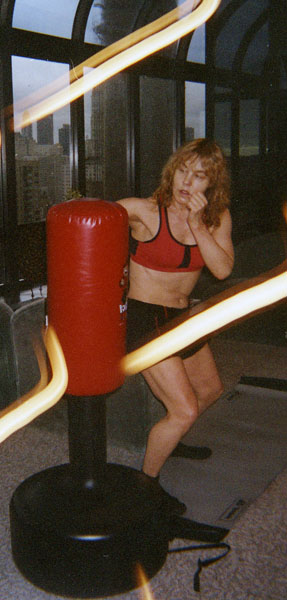

Ch19: PRINCIPLES
A cardio-strength class for three levels with options for split training.
KSSS is a cardio cross-training class for Levels II and III designed to avoid repetitive overuse by working on the step and the slide, varying the movement qualities and adding resistance with weights and impact with gloves on the bag for Level III. Often boxers will box too much for their cardio when it would be more beneficial to get a general cardio workout with ten minute intervals of kickboxing.
KSSS can be done all together if you want to knock yourself out, or separately.
Knockout Step/Slide/Strike is designed to be done at home, although it could be a club class. It doesn't require a special floor because it is low impact on the ground and high impact on the bag, which is optional. Ideally it combines steady state, endurance, cardio-strength, and anaerobic performance level training moving up to 92% of maximal heart rate for Levels II and III. Level III can combine weights with step aerobics, cross train and then do fast sliding with impact punching and kicking on the bag at the end of the ramp. Level I can use it slowly for rehab. Level II can split routines, doing Knockout Step one day and Slide and Strike the next. When you bike, your quads may burn out before your heart and lungs are fatigued, or your feet may hurt even though you could walk or run a longer distance. The point of this routine is to keep your heart rate high by switching to different muscle groups, using the Step to target buttocks, the Slide for ab-adduction, the weights for upper body and punches, and the quads for kicking. You are also forced to use your core muscles to slide and kickbox.
Level I should neither punch nor kick with impact. A few slow leg lifts and lunges on the step, a few minutes of lateral sliding, some balances and simple marching on the trampoline. Level I can use these modalities slowly, below heart training zone, especially for any kind of leg rehab once you have finished with Dr. Keefer's Corrective Clinic.
Level II
Yeah, I know: you have no time. This class can be split into two cross-training sessions of Knockout Step, using step aerobics, kickboxing moves, and endurance weight training, and Slide and Strike, using lateral training with a kick or punch into the bag when you reach the ramp at the end of the Slide. Level II should observe general population contraindications and work step aerobics and weight training separately, never lifting legs higher than ninety degrees. You may also want to just punch the bag and do knee lifts or focus exclusively on lateral sliding. Or you can do SSS together 30/30 or 20/40, depending on how your joints feel.
Level III
Get organized and do the real KSSS going from the step to the slide. It can also be done as a high-powered workout for elite athletes when you slide and strike with vigor, take off the booties and go up and down the step with weights. But this takes planning, organization and coordination. By kicking on the step you are forced to strengthen your standing leg and improve your balance. In martial arts, spectacular kicks are only as good as the foundation on which they stand.The point of combining slide with kicks and punches is to smooth out the advance and retreat, which can be difficult on concrete or carpets. You also have an extended cardio workout doing the slide, which is low-impact, simple and safe, thereby minimizing the actual time you kick and punch. This way you can do cardio for 60 minutes at most and only kick and punch for 15 minutes, working your heart and your technique without overworking your joints. This is important for Level II and for Level III-save yourself for the performance. Level I can go slowly on the slide and avoid the kicks and punches. Or lightly punch the air.
KSSS responds well to the 4/4 beat and 32-count phrase of hip hop. Because it is a steady state cardio strength workout, it requires a driving, even beat. The choreography is simple enough so that you don't have to stop and break it down. Aside from a few kicks, it is better to just do step aerobics with or without weights, followed by the open chain lying down body sculpting program with leg weights. Unless you are doing PT, Busy Body, or Advanced workouts at home where you want to combine the two, it is better to treat them as separate classes.
Slide/Strike is the rotation and impact class, which unlike regular boxing, is consistent and aerobic. It is a workout, not a martial art, but it is great conditioning for martial arts. With the right equipment, it could be a hit in health clubs.
Ch 20: SLIDE
Slide boards for lateral movement training were developed over a century ago by European speed skaters. Today’s models have a six-to ten-foot long plastic sliding surface with end ramps or blocks. Board width is two or three feet. While step targets the hamstrings and hip extensors, and biking the quads, slide boards target hip abductors and adductors and core muscles. While learning to slide you may not even be able to push yourself from end to end or get your heartrate up right away. If you are out of shape, you may get your heartrate up too quickly and too high so slow down, decrease the resistance. When you first start using the Slide, don’t be discouraged if you can only skate across half of it, or if you can only last five or ten minutes. I promise you will eventually get stronger. Move into a squat, and then push down into an undercurve. After using the Slide, clean and dry it before you roll it up. Wash out the booties every time as well.
Warm-up and Cool-down stretches for the inner and outer thighs.
Slide sequences for inner and outer thighs, quads and hams. 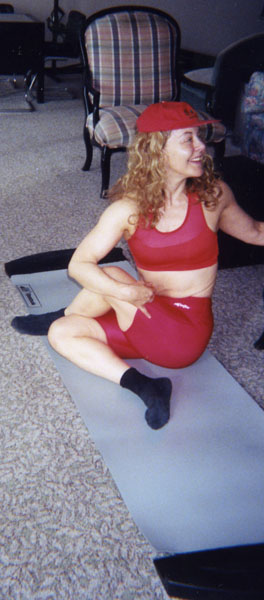
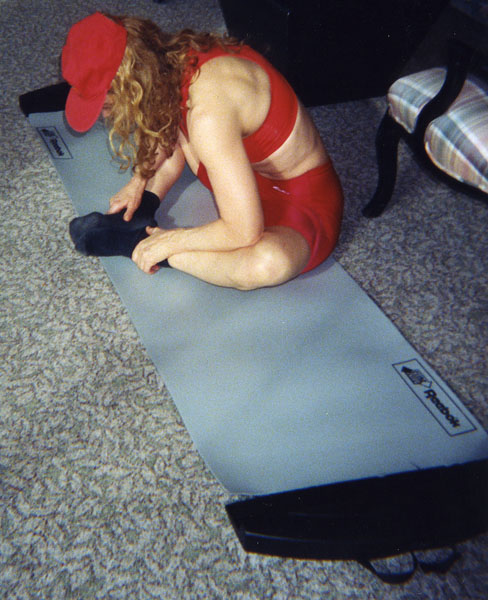
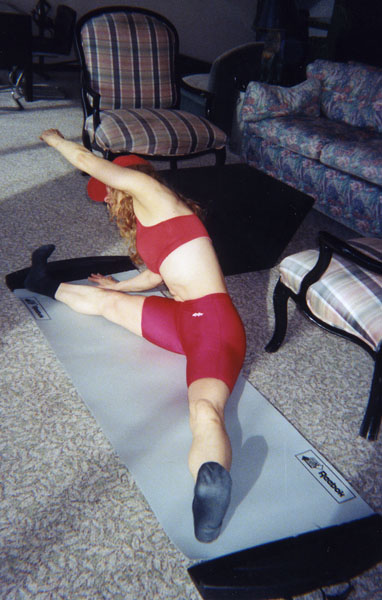 Add hamstring and lateral bending stretches for Levels II and III.
Add hamstring and lateral bending stretches for Levels II and III.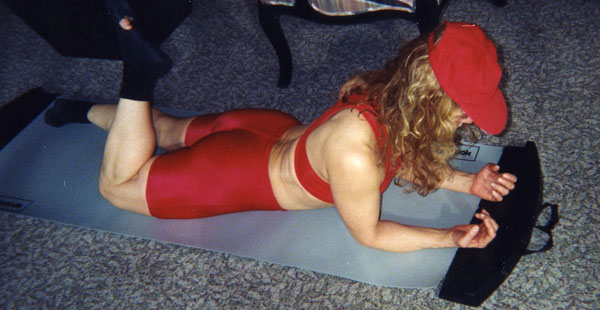 Stretch your abs and back in the TV watching position.
Stretch your abs and back in the TV watching position.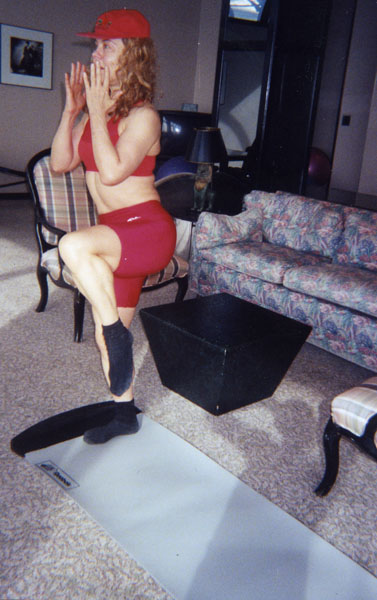 Begin with a simple back and forth motion across the Slide, then add knee lifts or hamstring curls.
Begin with a simple back and forth motion across the Slide, then add knee lifts or hamstring curls.
Ch21: STRIKE
Impact technique for kicks and punches.
Refer to the previous class, Knockout Ballet 'n Box for punching and kicking technique. Then practice punching on the light bag at the end of your Slide.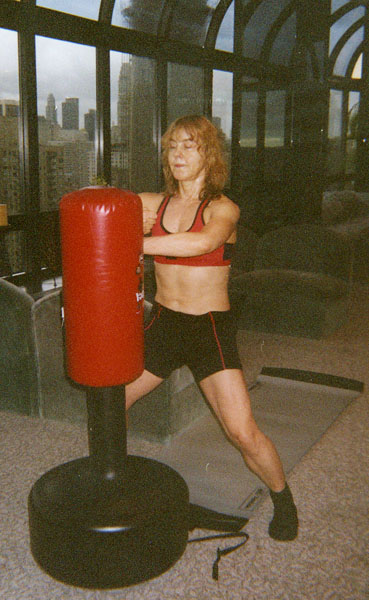
Ch23: PROGRESSIONS
Class progressions to target different training zones.
Ch24: SEQUENCES
From physical therapy to split cross-training sequences, or advanced choreography.
Combining lateral training with impact kickboxing minimizes repetitive overuse while keeping your heart rate up. The back and forth motion across the slide encourages a fluid advance and retreat from the bag, something that can be neglected when you focus on just hitting your target. The slippery surface allows you to rotate easily so that you punch and kick or bob and weave from your swinging core muscles. Slide/Strike is a smooth, choreographed sequence of movements executed with consistent control in a steady state cardio, slowly building in intensity, especially for more advanced levels. Performance
Keep the sliding action smooth and fluid, even though your punches and kicks are percussive.
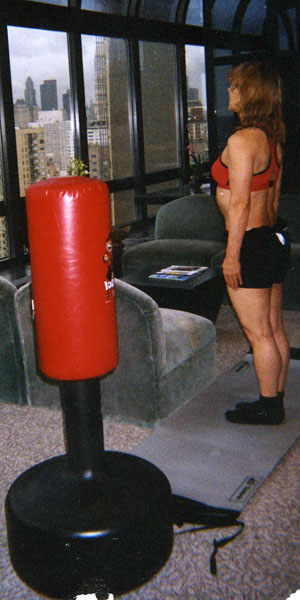
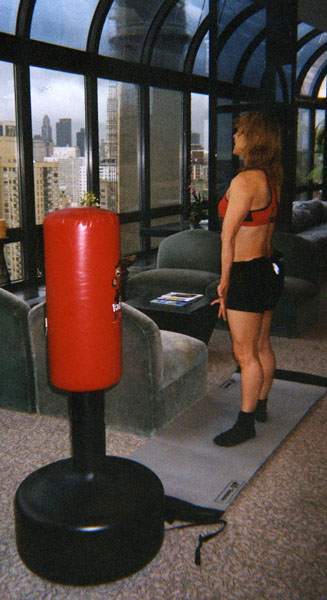 This warms up the hips before the more strenuous ab-adduction.
This warms up the hips before the more strenuous ab-adduction.
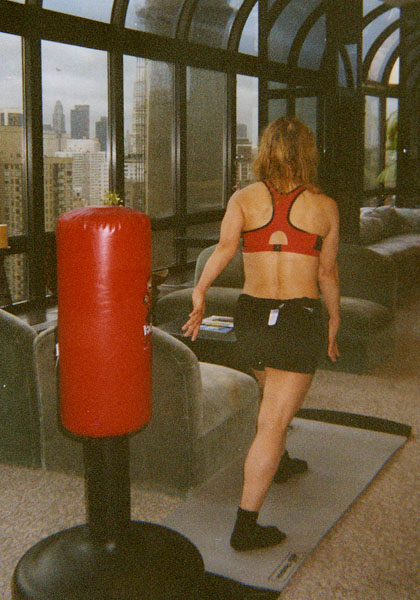 Cross-country ski motions are another way to warm-up or cross-train because this exercise works the front and back muscles, relieving the inner and outer thighs. It is lateral training but must include adductor ballet plies, front and back kicks and lunges, and internal/external rotation. Do sliding lunges forwards and backwards by glueing one foot to the end, and sliding the other foot into a lunge, moving forwards or backwards. Do plies in second position, contracting the inner thighs and closing the legs together in first position as if your thighs were scissors. The Slide is better for steady state cardio activities, but the Gliders are cheaper, more portable and permit a greater, and potentially more dangerous range of motion.
Cross-country ski motions are another way to warm-up or cross-train because this exercise works the front and back muscles, relieving the inner and outer thighs. It is lateral training but must include adductor ballet plies, front and back kicks and lunges, and internal/external rotation. Do sliding lunges forwards and backwards by glueing one foot to the end, and sliding the other foot into a lunge, moving forwards or backwards. Do plies in second position, contracting the inner thighs and closing the legs together in first position as if your thighs were scissors. The Slide is better for steady state cardio activities, but the Gliders are cheaper, more portable and permit a greater, and potentially more dangerous range of motion.
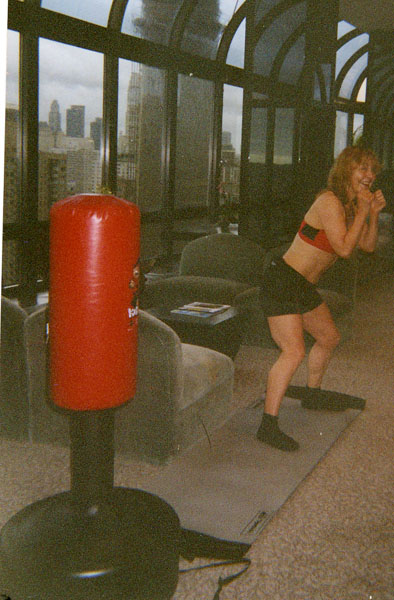 If you only have one bag, make sure you slide in both directions.
If you only have one bag, make sure you slide in both directions. 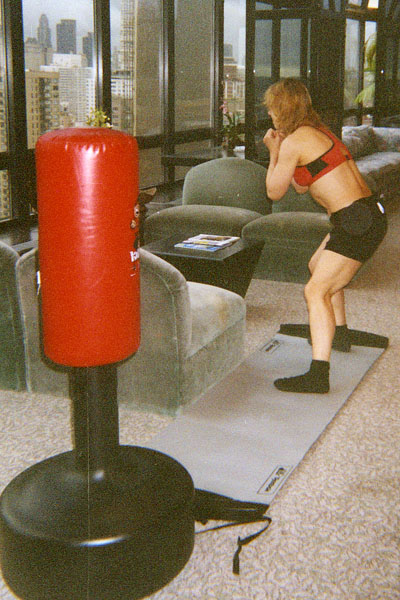 As you reach the end of the Slide, deliver a punch to the bag by rotating into a cross with the right arm.
As you reach the end of the Slide, deliver a punch to the bag by rotating into a cross with the right arm. 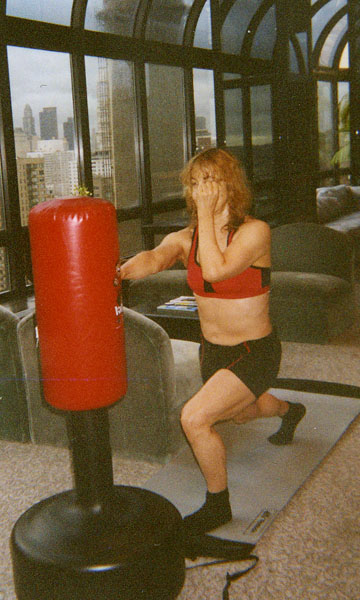
Before incorporating slides with kicks, make sure you can push all the way across, stop, balance and lift one knee.
 Always chamber up before kicking unless you are doing a crescent.
Always chamber up before kicking unless you are doing a crescent. Kick at each end of the ramp to balance your workout. You don't always have to hit the bag.
Kick at each end of the ramp to balance your workout. You don't always have to hit the bag.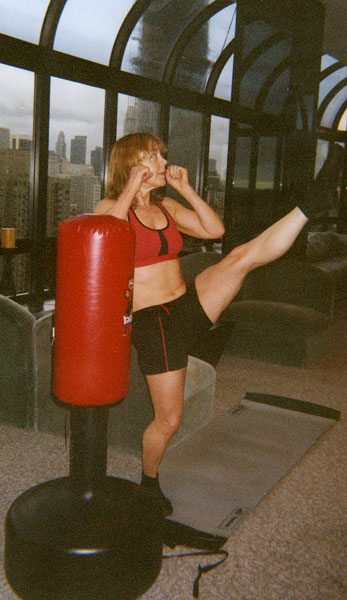
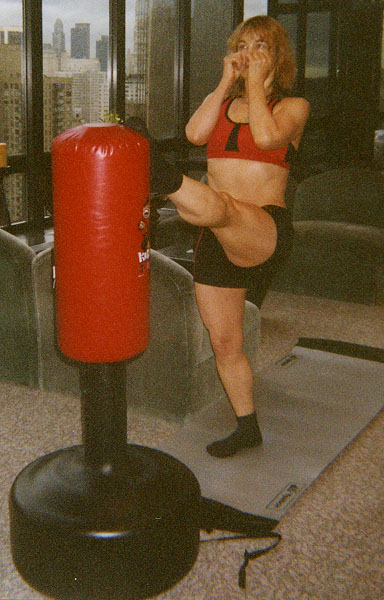 But the greater the impact, the stronger you get, as long as your joints can take it. In this case, the light bag is useful because this is a repetition, cardio-endurance class. Use the heavy bag for power training.
But the greater the impact, the stronger you get, as long as your joints can take it. In this case, the light bag is useful because this is a repetition, cardio-endurance class. Use the heavy bag for power training.
The movement I enjoy the best is the lateral slide into the lateral kick because I can get a great rhythm going. Stop, balance, chamber up,  and then strike,
and then strike, 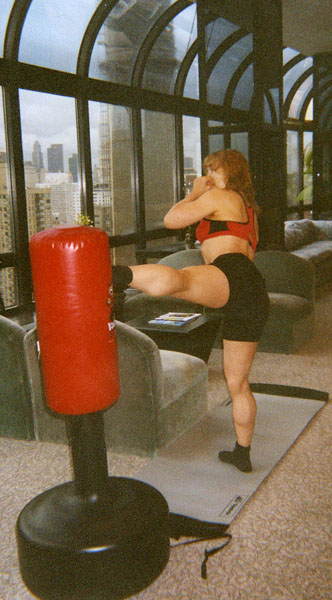 rechamber, lower the leg and push off in the other direction. Switch sides to strike the other leg on the bag. To balance the body make sure you do back kicks. If you have a bad back, just chamber up.
rechamber, lower the leg and push off in the other direction. Switch sides to strike the other leg on the bag. To balance the body make sure you do back kicks. If you have a bad back, just chamber up. 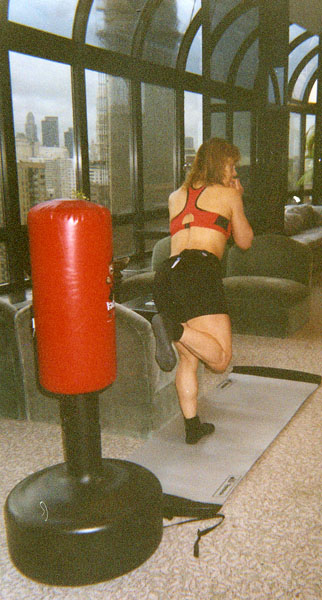 Otherwise, hit with your heel, squeezing your buttocks at the point of impact.
Otherwise, hit with your heel, squeezing your buttocks at the point of impact.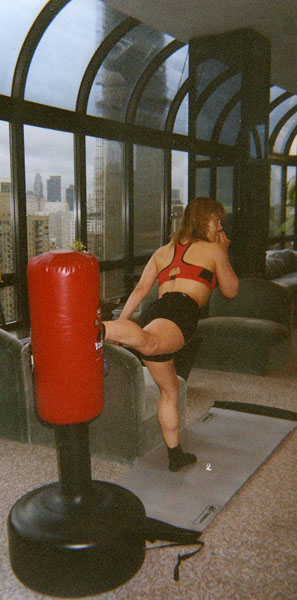
Gliding Crescents
Lie on a mat beside the Slide to slide legs up and down on the side or to do planks and presses.
Knockout Step and Sculpt
Ch21: STEP
Basic step routines for different levels to a hip hop beat.
Get your equipment ready and clear a space. Save the balls for Knockout Cardio-Core.
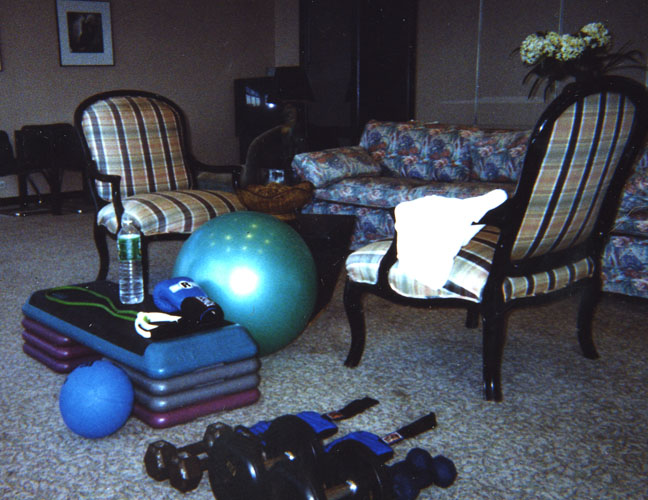
After your warm-up and stretch begin marching.
Take this into basics R and L.
123 tap rhythm for alternating basics, Vs, turn step, over the top, and across the top. 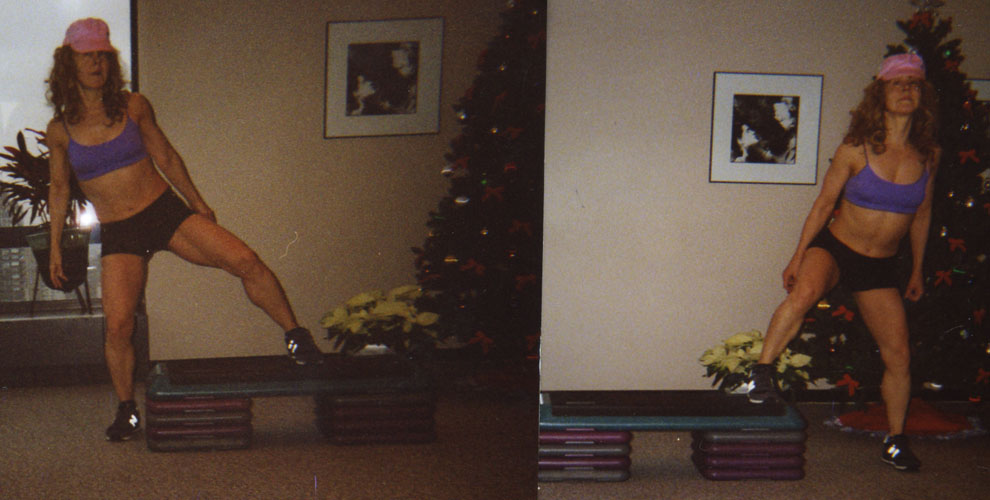 Add arabesque tap down and then across the top to make it harder.
Add arabesque tap down and then across the top to make it harder. 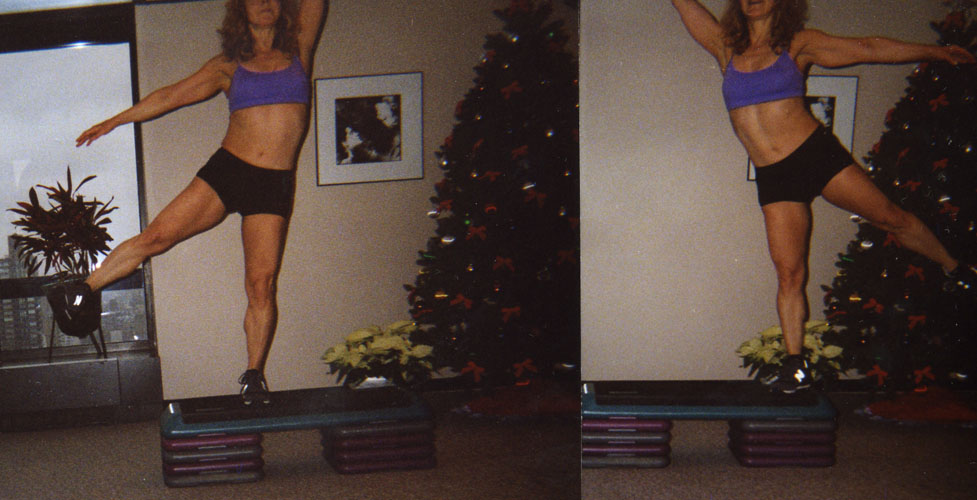
Leg Lifts
Step lift down down. Begin with knee lifts. Do leg side and arabesque. Hamstring curls.
Do leg side and arabesque. Hamstring curls.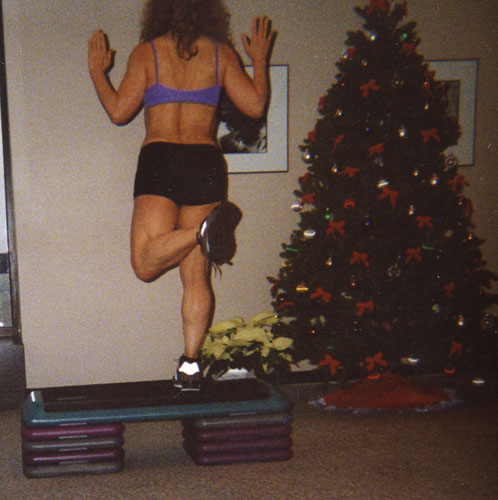
Knee straddle
Begin in a straddle down position.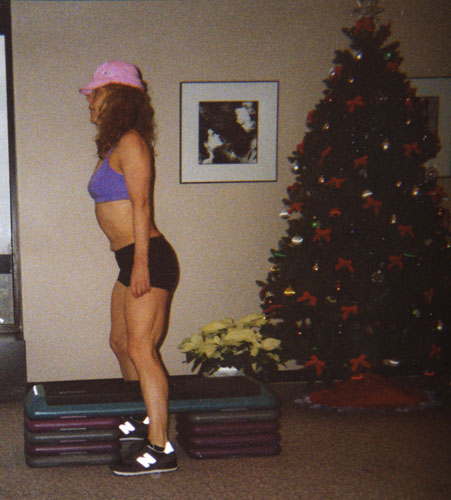 Step, lift, straddle down, alternating knees.
Step, lift, straddle down, alternating knees.
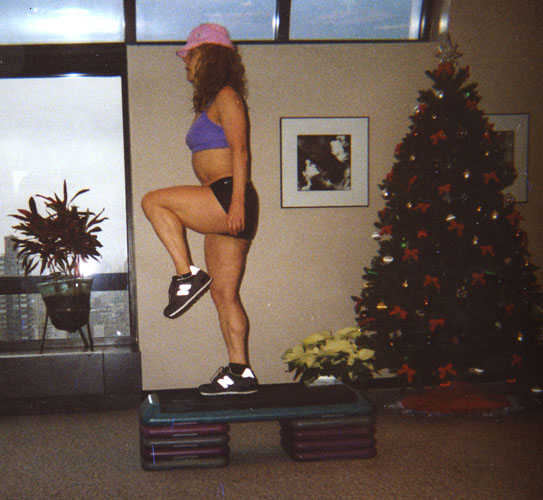

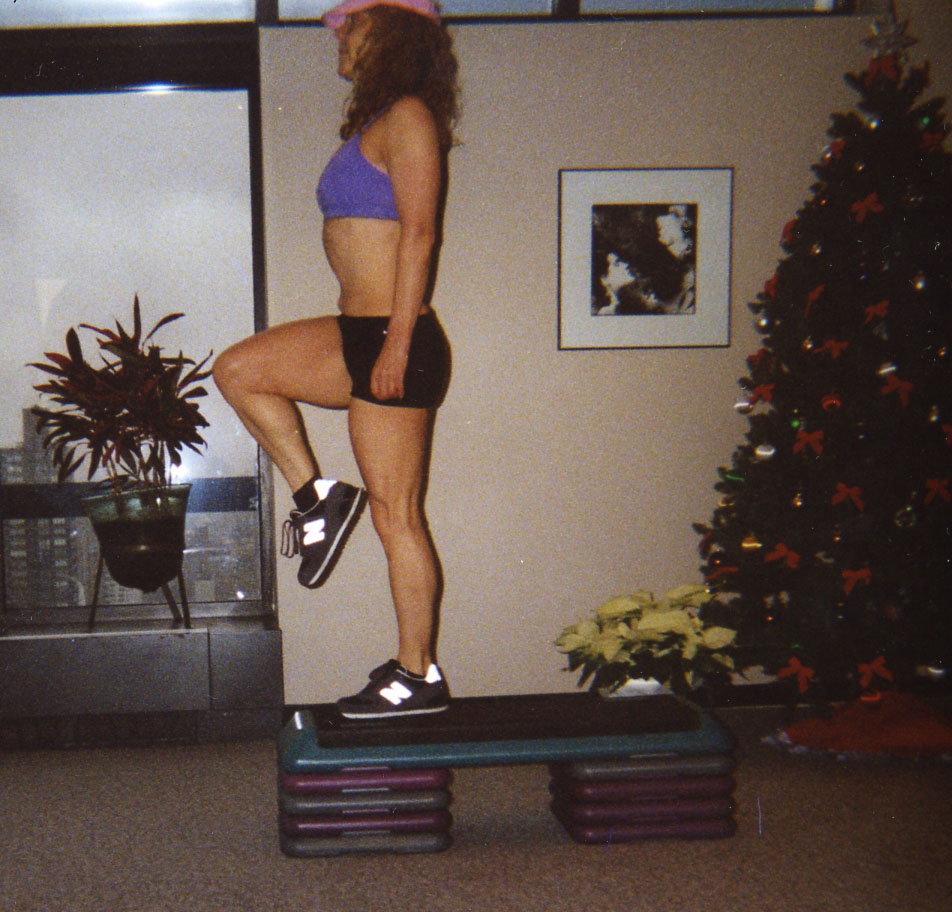
Level III: Kicking on the step strengthens your balance and the buttock muscles of your standing leg. When you kick in a real fight, you can lose your balance or get thrown if your standing leg isn't as strong as a tree. Kicking on the step will help you achieve this.
Lunges and Lifts
First weight interval.
Lift light weights while doing step aerobics for Levels II and III.
In Knockout Step do the lateral cross overs with the hips facing front. One legged squats with barbell.
Second Weight Interval
To increase the intensity of concentric and eccentric phases, combine weights with bands.
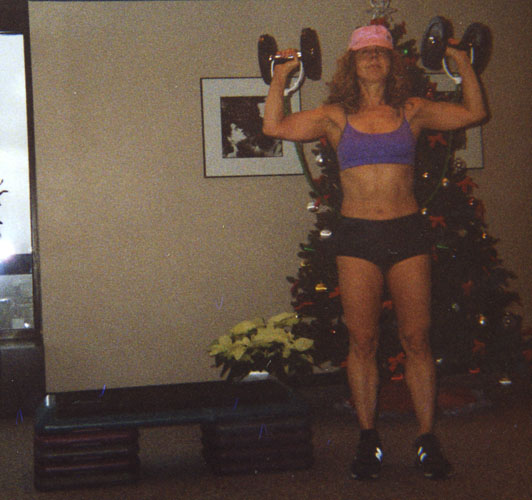 As you press overhead the resistance of the band makes it more difficult when the weights become easier.
As you press overhead the resistance of the band makes it more difficult when the weights become easier.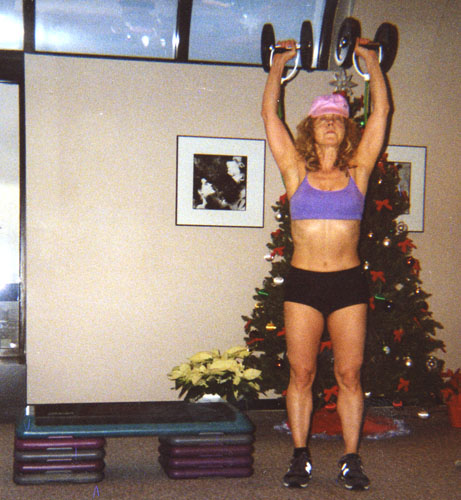
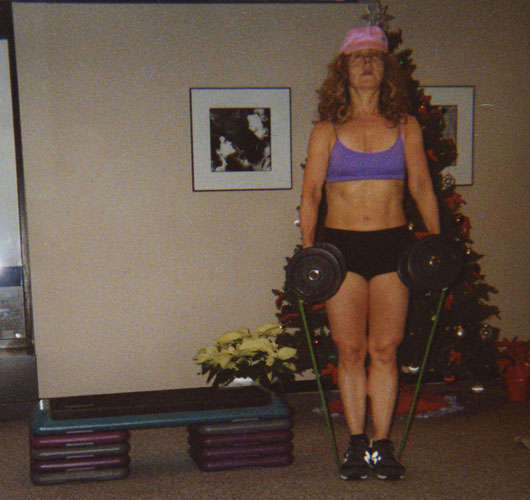 To work the supraspinatus do a low lateral raise.
To work the supraspinatus do a low lateral raise.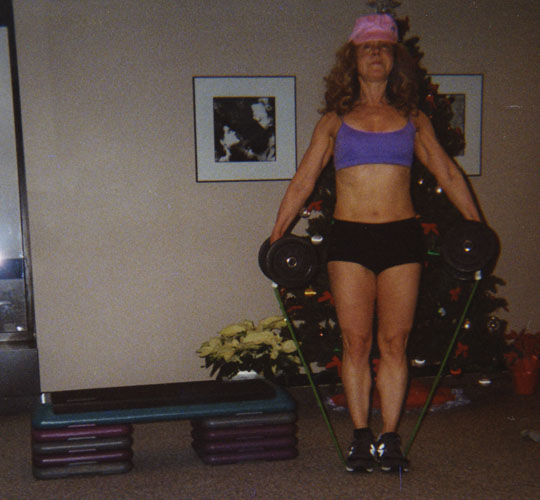 Go higher to target the lateral deltoid.
Go higher to target the lateral deltoid.
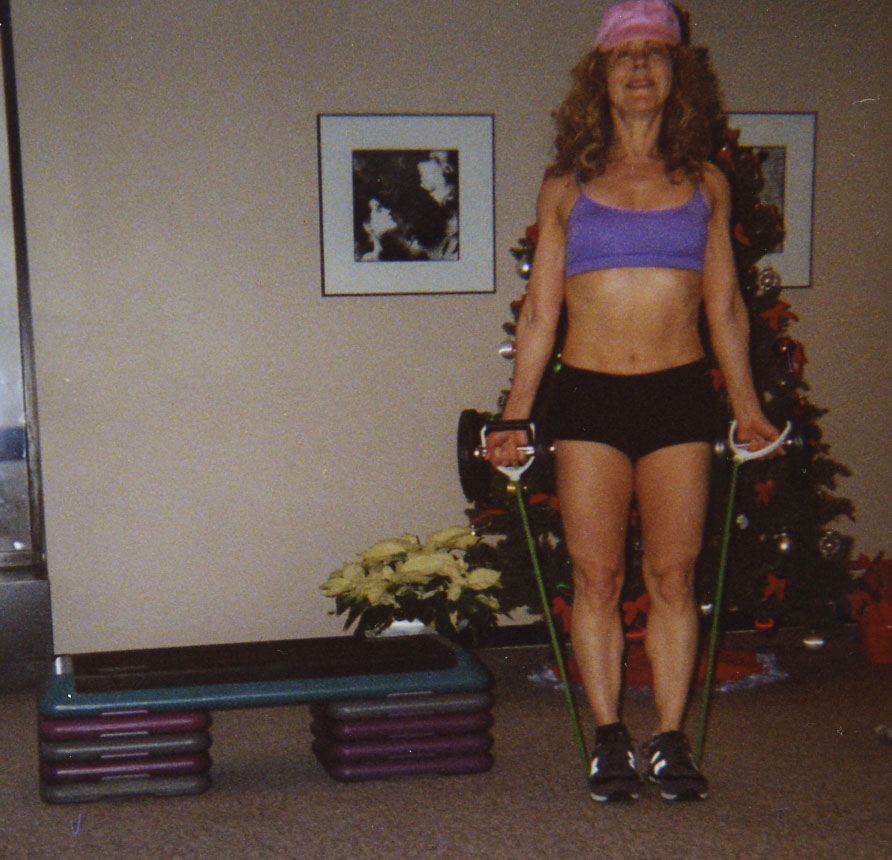
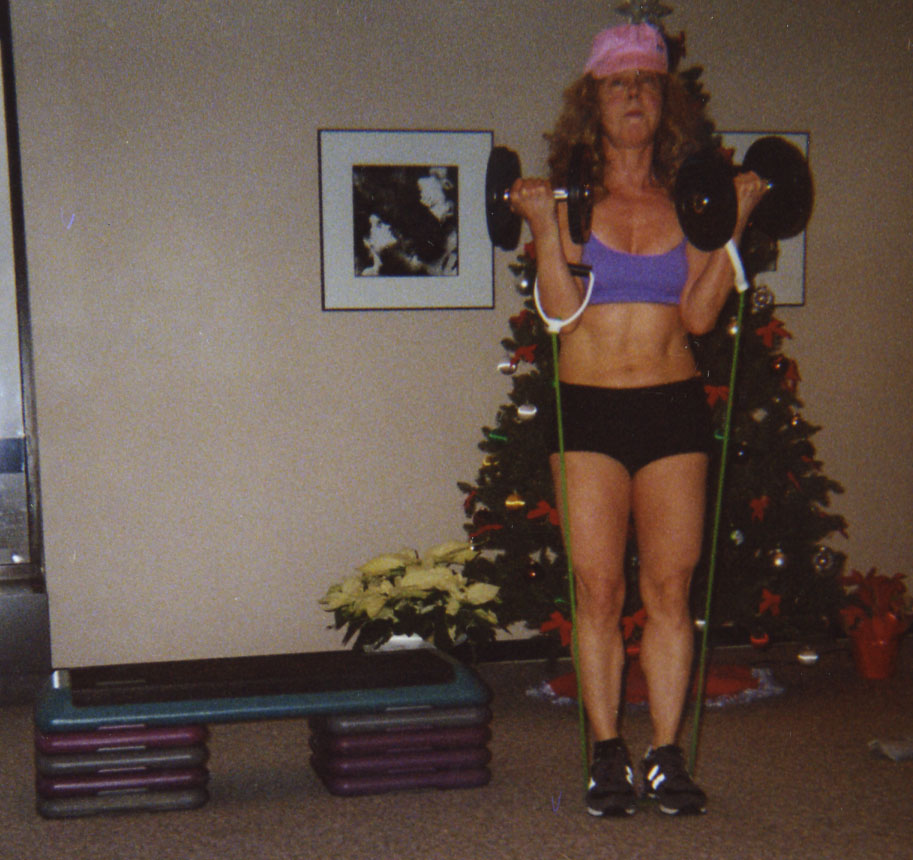 This is a great way to work out heavy at home--bands and weights. Lower slowly on the bicep curl.
This is a great way to work out heavy at home--bands and weights. Lower slowly on the bicep curl.
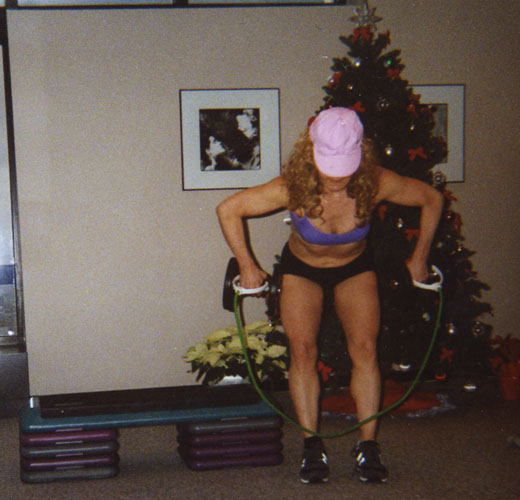 Step on the band to do rows!
Step on the band to do rows!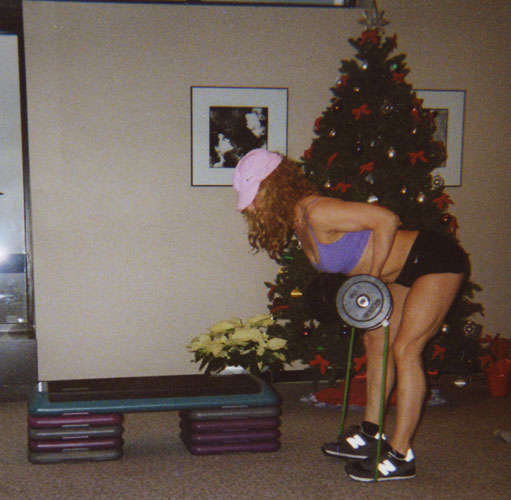 Bend and straighten arms keeping elbows still. Triceps can be worked in supine lying on the step,
Bend and straighten arms keeping elbows still. Triceps can be worked in supine lying on the step,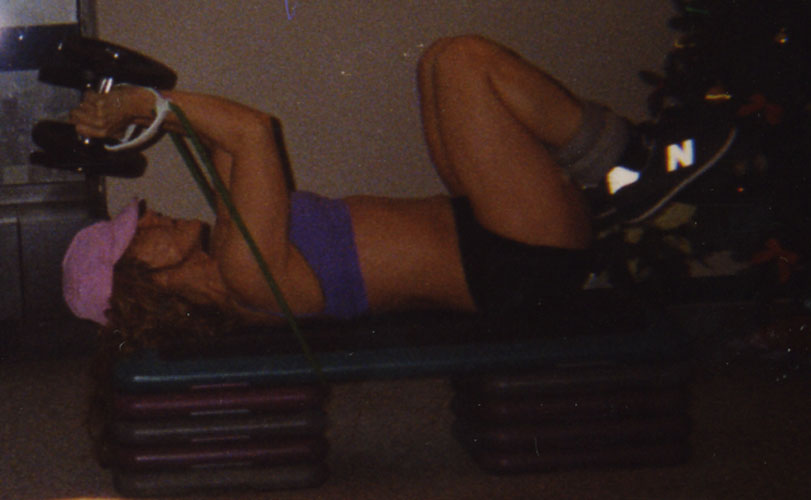 or lying on the stomach on the step.
or lying on the stomach on the step.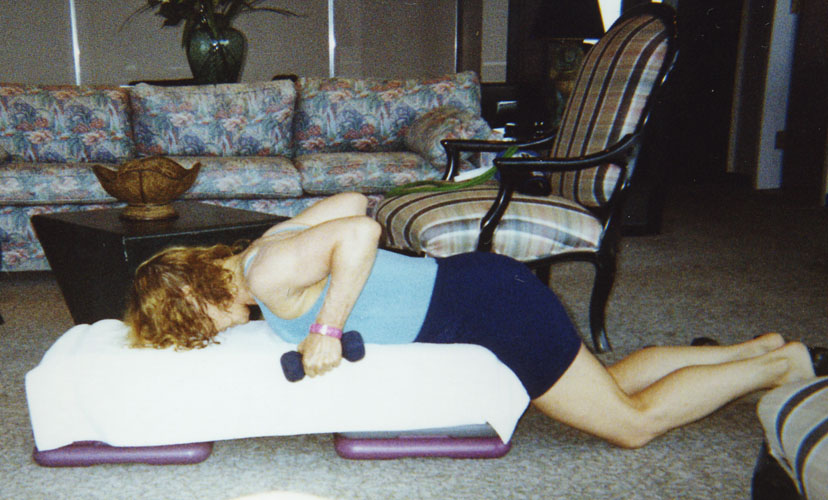 In this prone position on step lift your straight arms overhead to work lower trapezius and posterior deltoid.
In this prone position on step lift your straight arms overhead to work lower trapezius and posterior deltoid.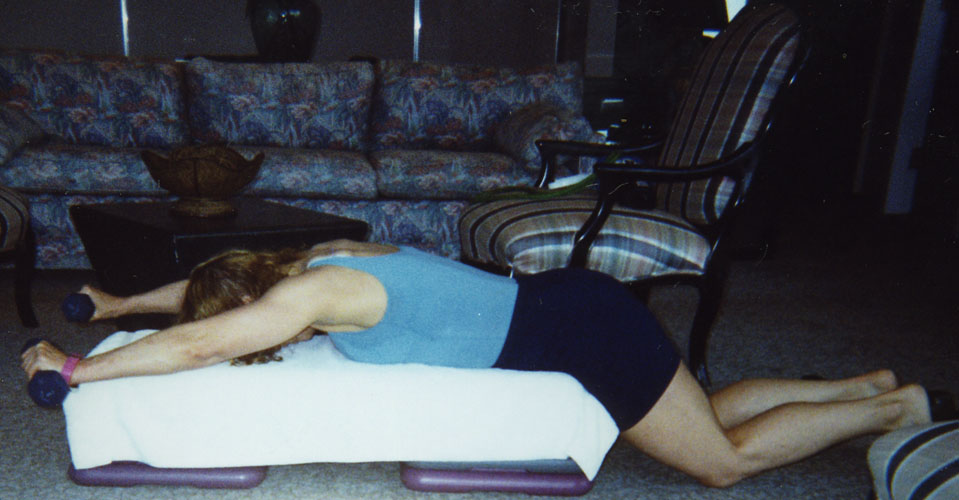
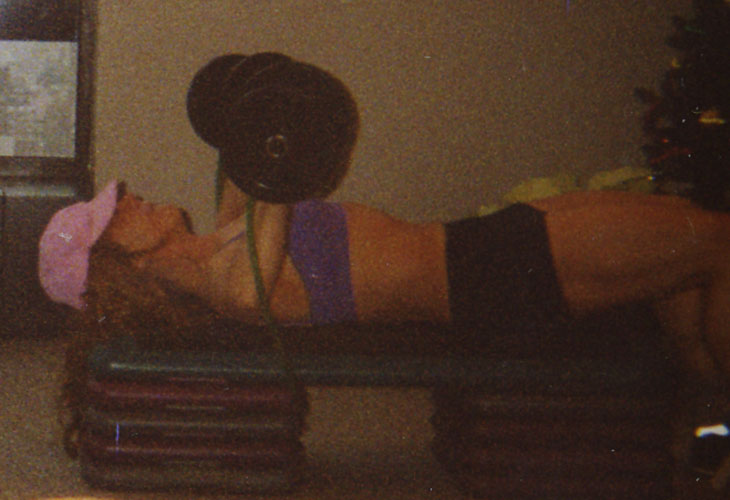 Place the band under the step for flys and chest presses.
Place the band under the step for flys and chest presses.
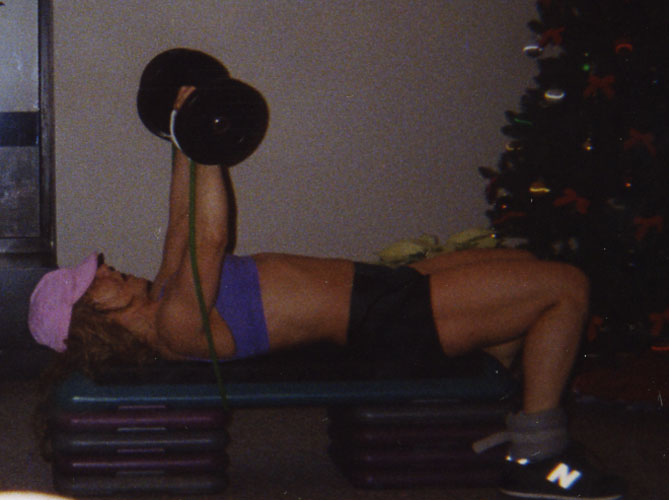
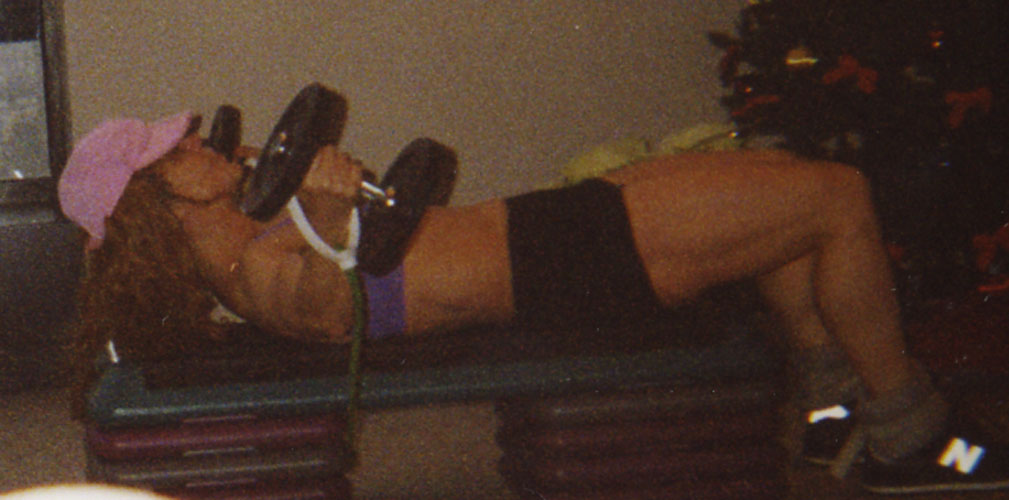 Open and close arms and legs.
Open and close arms and legs.
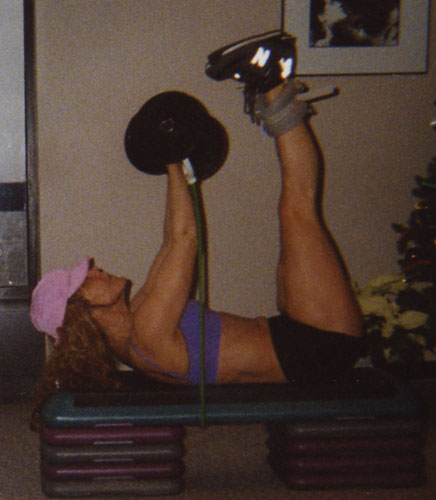 At this point you can put ankle weights on for the open chain ab-adduction and butt sequences, which can be done standing turned in and turned out to increase strength and ROM for all your kickboxing and ballet kicks, then side-lying, prone, anbd supine to further isolate muscles. .
At this point you can put ankle weights on for the open chain ab-adduction and butt sequences, which can be done standing turned in and turned out to increase strength and ROM for all your kickboxing and ballet kicks, then side-lying, prone, anbd supine to further isolate muscles. .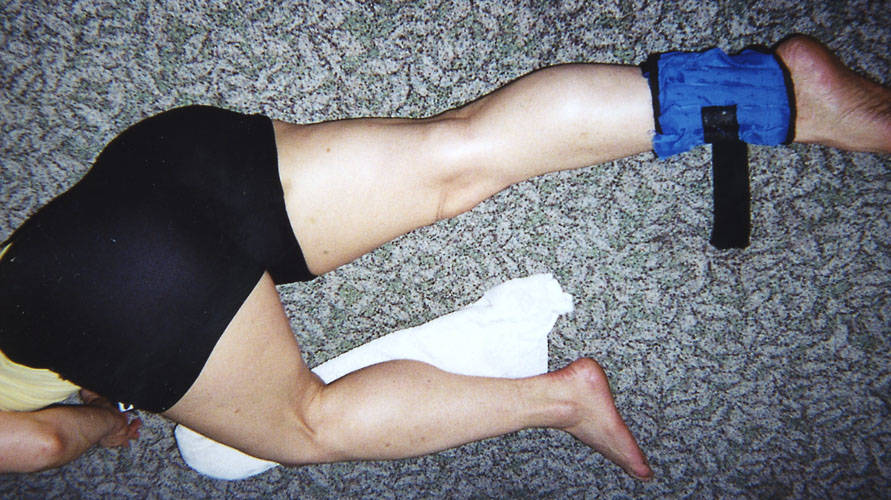 Back exercises over the step prevent excessive hyperextension.
Back exercises over the step prevent excessive hyperextension.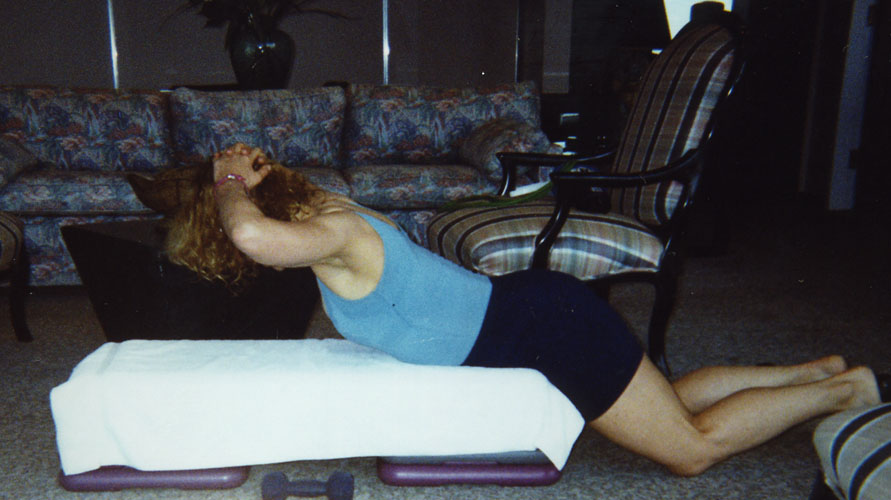
Floor Work: Stretch and cool-down with ankle weights by doing open chain exercises supine, prone, and side-lying.
Just as you focused on different activities during the different seasons, you can vary your workouts. Once you get good at step aerobics, do more of the slide. The body trains in response to stress or new demands placed on it.
KNOCKOUT CARDIO-CORE with AEROBIC GUT AND BUTT